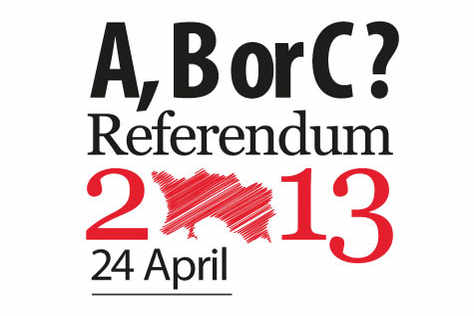There are three options to choose from and voters can either just vote for their favourite one, or place two in order of priority.
The three options were put forward by an Electoral Commission set up by the States and these remained exactly the same after a series of public consultation meetings held last year.
The three options are as follows:
Option A
The role of Senator, which holds an Island-wide mandate, would be scrapped and Constables would no longer sit in the States. Instead the Assembly would be made up of 42 Members, known as Deputies, elected for four-year terms and serving six large districts.
This is the only one of the three options that removes the Constables from the States and would mean that every States Member would be elected by roughly the same number of voters.
Option A supporters include businesswoman Christine Vibert, who is their spokeswoman, Electoral Commission member Dr Jonathan Renouf, Deputy Montfort Tadier, law student Sam Mesec, Jan Dart and former Senator Ted Vibert.
The proposed districts, which would represent an average of 1,845 voters per Deputy, would be as follows:
District 1: St Helier Vingtaines du Mont Cochon, du Mont à l’Abbé, de Haut du Mont au Prêtre and du Rouge Bouillon. Total eligible voters: 13,960.
District 2: St Helier Vingtaines Bas de Haut du Mont au Prêtre, Canton Bas de la Ville and Canton de Haut de la Ville. Total eligible voters: 12,900
District 3: St Clement, Grouville and St Martin. Total eligible voters: 14,010
District 4: St Saviour and Trinity. Total eligible voters 12,960
District 5: St Lawrence, St John, St Mary and St Ouen. Total eligible voters 11,100
District 6: St Brelade and St Peter. Total eligible voters 12,600.
Option B
The role of Senator, which holds an Island-wide mandate, would be scrapped, but Constables would retain their seats in the States.
The Assembly would consist of 42 Members made up of 30 Deputies, elected for four-year terms and serving six large districts, and 12 parish Constables. Each district would be represented by five Deputies.
‘A leaner, fitter, more efficient States’ is how campaigner Ben Shenton describes the effect of Option B. Its only difference to Option A is that it retains the Constables.
Option B supporters include Chief Minister Ian Gorst, electroal Commission member Senator Sir Philip Bailhache, Senator Philip Ozouf and former States Members Jimmy Perchard, Pierre Horsfall, Don Filleul, Bill Morvan, Geoffrey Grime and Andrew Lewis.
The proposed districts, which would represent an average of 1,845 voters per Deputy, would be as follows:
The proposed districts are as follows:
District 1: St Helier Vingtaines du Mont Cochon, du Mont à l’Abbé, de Haut du Mont au Prêtre and du Rouge Bouillon. Total eligible voters 13,960.
District 2: St Helier Vingtaines Bas de Haut du Mont au Prêtre, Canton Bas de la Ville and Canton de Haut de la Ville. Total eligible voters: 12,900.
District 3: St Clement, Grouville and St Martin. Total eligible voters 14,010.
District 4: St Saviour and Trinity. Total eligible voters 12,960.
District 5: St Lawrence, St John, St Mary and St Ouen. Total eligible voters 11,100.
District 6: St Brelade and St Peter. Total eligible voters 12,600.
Option C
Option C is the only one to retain the role of Senator, which holds an Island-wide mandate, although the States have already agreed to reduce the number of Senators to eight by next year.
Option C proposes an Assembly of 49 Members, made up of eight Senators, 29 Deputies in parish or parish districts and 12 parish Constables.
Option C supporters, led by Senator Lyndon Farnham, warn that under A and B, the vast majority of the public – 83 per cent – will have no say in electing the Chief Minister as they would have been chosen by just one district.
They also cite a survey carried out a few years ago by researchers Mori on behalf of the States, which asked 1,000 voters in Jersey for their views. they say that 46 per cent wanted all States Members to be elected Island-wide and just a fraction wanted the Island to be divided into super-constituencies.
How to vote
Providing you are on the electoral register, go along to your parish hall or polling station on 24 April. You will be asked to choose your first and second choices and a transferable voting system will be used to obtain a result.
Pre-poll voting is also open until Friday 19 April at St Paul’s Centre, Dumaresq Street, from 9 am until 5 pm each weekday, except on the final day when it closes at 2 pm.
How the results will be declared
The results will be announced publicly in each parish before States Greffier Michael de la Haye counts them all at a central location, after which the Island-wide result will be declared.
If one of the three options has obtained more than 50 per cent of the votes cast, that option will be the winner.
If none of the three options has obtained more than 50 per cent, Mr de la Haye will declare which of the three received the least number of votes and these will be reallocated to the remaining two piles, according to the second preference shown, if a second preference has been shown.
• The results will be published here at www.thisisjersey.com as they are announced






